|
Diplopoda
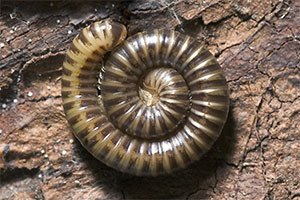 Eumastigonus
Eumastigonus sp., native Spirostreptida, New Zealand.
Common name: millipedes, Maori weri mano.
Scienific name: phylum Arthropoda, class Diplopoda. From Greek “diplos”, two, and “poda”, legs, referring to two legs per segment.
Description
The millipedes are easily recognizable. Most of them are slow-moving, elongate animals with a cylindrical or flattened segmented body (trunk), a rounded head and a large number of short walking legs. The cuticle of most millipedes is calcified and rather hard, and the body is relatively inflexible.
Each body segment is covered with hard plates, or sclerites. In many millipedes the plates are fused together to various degrees, each segment often forming an almost solid ring. Millipedes differ from other myriapods (multi-legged arthropods, such as centipedes and Symphyla) by having two pairs of legs on most body segments (hence the name Diplopoda). The first
body segment after the head, the collum, has no legs. The
three following segments each carry a single pair of legs.
Most other segments of the body, the so-called diplosegments,
all have two pairs of legs, except for the legless terminal
segment. The presence of diplosegments, which are formed during
embryonic development by fusion of two adjacent embryonic
segments, is one of the defining characters of Diplopoda. Juvenile
millipedes may have several legless segments at the end of
the body. Contrary to their name, millipedes do not have thousand
legs, although the number of legs is still very large. For
example, a large New Zealand millipede Eumastigonus sp. has 186
legs (93 pairs). In male millipedes, the legs of the 7th body
segment are modified for sperm transfer and are called “gonopods”.
The shape of the gonopods is an important taxonomic character
for identification of genera and species.
The head of a millipede bears well-developed
antennae, eyes (if present), and chewing mouthparts with strong
mandibles, with which millipedes masticate dead wood and plant
debris, their common food. The antennae consist of 6-8 segments
and bear various sensory organs, including receptors for smell,
taste, touch, and temperature. The eyes, if present, are located
on the sides of the head, and consist of one or a group of
simple eyes (ocelli). Many of the common litter millipedes
– for example all Polydesmida – are eyeless.
The millipedes are a very diverse group,
and show a variety of body forms, colours and sizes. The size
of millipedes varies from 2 mm to 30 cm. Most of the New Zealand
species are 2-5 cm in length, brown, grey or black in colour.
Some tropical species can be bright orange, blue, or red.
There are 15 recognized orders of millipedes, and their taxonomy
is continuously under revision. The main groups found in New
Zealand are described below.
Bristle millipedes - order Polyxenida
The small size and unusual appearance of
bristle millipedes may cause them to be mistaken for insect
larvae or springtails. The polyxenid millipedes are only 2-5
mm long, with soft, non-calcified cuticle and a short (11-13
segments) body, which is covered with tufts of bristles. In
New Zealand I have occasionally found bristle millipedes in
litter samples, but they are not common.
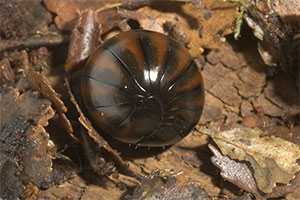 Procyliosoma striolatum
Procyliosoma striolatum, a pill millipede
endemic to New Zealand.
Pill millipedes – order Sphaerotheriida
Similar to terrestrial isopods (slaters) pill millipedes roll into a sphere when disturbed, the ability for which they have received their name. New Zealand pill millipedes are members of the order Sphaerotheriida, a group with a Gondwanan distribution, with ~100 species known from Australasia, South Africa, and Madagascar. New Zealand pill millipedes Procyliosoma (5 species) reach 1-3 cm in length and are found in native forests, where they inhabit humus and leaf litter, especially at the bases of trees.
“Juliform” millipedes – orders Julida and Spirostreptida
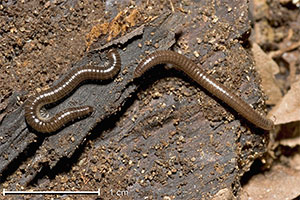 Ophyiulus pilosus
Ophyiulus pilosus, an introduced Julida widespread
in New Zealand. Juliform millipedes are the familiar smooth, cylindrical grey or brown millipedes, often found in rotting wood, in leaf litter, and under logs. Juliform millipedes have numerous small legs and larger number of segments than the flat-backed and pill millipedes. The native New Zealand species, often found in forests, belong to the order Spirostreptida. A number of introduced species (mainly European) belong to the order Julida. Unfortunately, these two orders look very similar and may share the same habitat, so a juliform millipede cannot be readily identified as Julida or Spirostreptida without a close-up examination under a dissecting microscope. When harassed, juliform millipedes secrete yellowish defensive fluid, which contains benzoquinones and which has a very strong, unpleasant and tenacious smell.
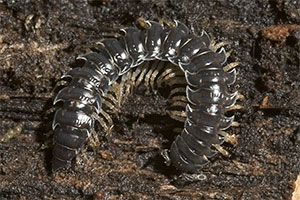
Pseudoprionopeltis sp., a polydesmid millipede, New
Zealand.
Flat-backed millipedes – order Polydesmida
Millipedes of the order Polydesmida are flattened. The dorsal plate of each body segment extends laterally, forming side projections, or paranota. The dorsal plates and paranota are often ornamented with ridges, tubercles, and patches of colour. In New Zealand, polydesmid millipedes are common in all environments, dwelling in leaf litter, under rocks, and under the bark of rotting logs. All Polydesmida are eyeless.
Other millipedes
Members of the order Chordeumatida, very common in native
New Zealand forests, are surface runners, and are quite agile
for millipedes. Chordeumatid millipedes are relatively soft,
with a slightly flattened body and longer legs visible from
above. The body is tapered towards the end. Millipedes from
the orders Siphonophorida and Polyzoniida are small, elongated,
and slow-moving animals.
 Schedotrigona
Schedotrigona sp., an active native Chordeumatida
millipede, New Zealand.
|

This millipede from the order Siphonophorida is 0.5 cm long.
There is one species in New Zealand.
|
Notes on biology
Most millipedes are detritivores and fungivores,
feeding on decaying vegetation, dead wood, and similar materials.
Millipedes use the help of symbiotic microorganisms living
in their gut to break down and digest the plant cellulose;
in addition, millipedes digest the fungi and bacteria that
inhabit decaying vegetation and rotting wood. Some millipedes
will scavenge, eating dead animal matter. Occasionally, millipedes
may feed on live plant tissue – roots and tubers, and
also on fallen fruit, and so they may become pests in areas
of high population density.
Millipedes have separate sexes. Male and
female clasp each other during mating, and the male uses his
modified legs – gonopods, to transfer the sperm packet
(spermatophore) to the female. Female millipedes lay hundreds
of eggs in soil, leaf litter, etc., often building a protective
nest. Parthenogenetic reproduction is known in some species.
The young millipedes hatch with only three pairs of legs.
Although small and colourless, they resemble adults in shape,
and grow gradually through a series of moults, adding more
segments and legs with each moult. In temperate zone, millipedes
take one to several years to reach maturity, hibernating during
winter in colder climates. Some millipedes reproduce only
once and then die, while other species live for several years
as adults, reproducing repeatedly. Large tropical species
grow slowly, and may live for many years as adults.
Slow-moving and unflexible, millipedes
lack active defenses. To discourage predators they may roll
into a ball or coil into a tight spiral, so that only tough
exoskeleton is exposed. In addition, many millipedes exude
toxic or foul-smelling substances that repel predators. The
repellent fluid is produced in special glands in each segment,
and is released through lateral ozopores; these can be seen
as a row of dots along each side of the body. Millipedes use
a wide range of defensive chemicals. Juliform millipedes use
benzoquinones and other compounds, polydesmid millipedes use
cyanide. Small mammals, birds and predatory arthropods may
eat millipedes, although mammals and birds often avoid millipedes,
if given a choice. The repellent fluid of large tropical millipedes
can be irritating to human skin.
Miillipedes are very important in soil
ecosystems – they are one of the few groups able to
fragment dead wood and plant debris into smaller pieces, pre-processing
the organic material and making it available for further decomposition
by fungi, bacteria, and microinvertebrates. In forest soils
in particular, millipedes facilitate decomposition of woody
debris and leaf litter, support soil food webs, and aid in
nutrient cycling and soil formation. In some countries, during the reproduction period
in spring or summer, or during autumn in the search for overwintering
sites, adult millipedes occasionally appear in mass quantities.
Millipedes are generally not considered to be pests, but they
can be a nuisance in urban environments if they aggregate in
large numbers.
Where to find them?
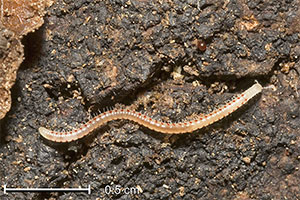 Blaniulus guttulatus
Blaniulus guttulatus, a "spotted snake millipede"
- introduced and widespread in New Zealand. Millipedes are common litter and soil animals in New Zealand. As in all other Myriapda, millipedes lack a waxy layer on the cuticle, and therefore dessicate easily if exposed to dry air. The millipedes prefer damp, protected habitats – they are common underneath logs, under rocks, in rotting wood, in moss, and in leaf litter. Many millipedes live burrowing through the dead wood of decomposing logs or through matted layers of litter. Around human habitations millipedes are common under mulch, leaf litter and compost in gardens, and under tiles, stones, flower pots, and piles of debris in damp situations. Most millipedes are nocturnal and they generally avoid the light.
If discovered, millipedes will try to move away, although many species are very slow walkers. Pill millipedes roll into a perfect ball if disturbed, many other species coil their body into a tight spiral and remain immobile, relying on their chemical defences. Millipedes are harmless and do not bite, but if picked up, many will secrete a defensive fluid from ozopores, which may irritate the skin and stain cloths, and which often has an extremely tenacious bad smell.
Millipedes can be preserved in alcohol,
but will become brittle and loose their colour. In addition,
identification of millipedes is very challenging. Many species
and genera are superficially similar, so only an experienced
taxonomist can distinguish one from another, and many New
Zealand species are still undescribed and unnamed. For a non-specialist,
I would recommend observing and photographing live millipedes,
rather than collecting them.
Distribution and conservation
Millipedes are common all over the world,
they are particularly diverse in the tropics. Worldwide, 16 orders, 135 families, and close to 11,000 species
of millipedes have been described. It is estimated that there
are approximately 80,000 species in the global millipede fauna.
Diplopod taxonomy is constantly changing.
The fauna of New Zealand is still poorly known. The New Zealand
millipedes occur in all environments, but are most common
and numerous in forests. Approximately
12 families and ca. 60 species of millipedes have been described
from New Zealand, several hundred species are awaiting description,
and many more species remain undiscovered. We know very little
about the distribution, biology, and ecological importance
of New Zealand millipedes.
Millipedes are cryptic animals, and can
be spread by unsuspecting humans with soil, garden materials,
vegetables and wood. Presently, twelve exotic species of millipedes
are common in urban gardens and urban woodlands of New Zealand,
having been introduced from Europe. Australian Akamptogonus
novarae (Polydesmida) has been introduced to New Zealand
as well. The exotic Ophyiulus pilosus, Blanuilus
guttulatus and Cylindroiulus britannicus (Julida)
are the three most common millipedes in New Zealand gardens.
Millipedes are not protected in New Zealand.
Included images:
- Order Siphonophorida
- Family Siphonophoridae
- Siphonophora ?zelandica? (Chamberlin, 1920) - Ohinetonga Scenic Reserve, TO, North Island (3 images)
- Order Sphaerotheriida
- Family Sphaerotheriidae
- Procyliosoma striolatum (Pocock, 1895) - Canaan Road near Harwood Hole, NN, South Island (3 images)
- Order Polyzoniida
- Family Siphonotidae
- Siponethus sp. - Te Purere, TO, North Island
- Order Chordeumatida
- Family Metopidiotrichidae
- Schedotrigonia sp. - Karori wildlife sanctuary, WN, North Island
- Schedotrigonia sp. - Canaan Road near Harwood Hole, NN, South Island
- Schedotrigonia sp. - Rimu Valley Walk, SD, South Island
- Schedotrigonia sp. - Kahurangi National Park, Flaro Saddle, NN, South Island
- Schedotrigonia sp. - Kaiteriteri Road, NN, South Island (2 images)
- Schedotrigonia sp. - Westland National Park near Okarito, WD, South Island
- Schedotrigonia sp. - Kawhatau Base, RI, North Island
- Order Polydesmida
- Family Paradoxosomatidae
- Akamptogonus novarae (Humbert et Saussure, 1869)* - Ohinetonga, To, North Island
- Family Dalodesmidae
- Tongodesmus sp. - Te Purere, TO, North Island
- Tongodesmus sp. - Kahurangi National Park, Flora Saddle, NN, South Island (2 images)
- Icosidesmus variegatus - Craigieburn Forest Park, Cave Stream, NC, South Island
- Icosidesmus sp. 1 - Palmerston North, WI, North Island
- Icosidesmus sp. 2 - Palmerston North, WI, North Island
- Pacificosoma ?yaldwyni? - Palmerston North, WI, North Island (2 images)
- Pacificosoma ?yaldwyni? - Palmerston North, WI, North Island
- Pseudoprionopeltis sp. - Canaan Road near Harwood Hole, NN, South Island
- Pseudoprionopeltis sp. - Canaan Road, NN, South Island
- Pseudoprionopeltis cinereus (Carl, 1902) - Torlesse Range, Porters Pass, NC, South Island
- Pseudoprionopeltis cinereus (Carl, 1902) - Hawdon Valley, NC, South Island
- Dityloura sp. - Hawdon Valley, NC, South Island (2 images)
- Other
- Unidentified sp. undescribed - Canaan Road, NN, South Island
- Unidentified sp. undescribed - Kaiteriteri Road, NN, South Island (2 images)
- Unidentified sp. - Peel Forest Park, Dennistoun Bush, SC, South Island
- Unidentified sp. - Katikara Stream, Taranaki, TK, North Island
- Unidentified sp. - Lake Wilkie-Tautuku Beach, Catlins, Southland, SL, South Island (3 images)
- Unidentified sp. - Trounson Kauri Park, Northland, ND, North Island (2 images)
- Order Spirostreptida
- Family Cambalidae
- Eumastigonus sp. - Katikara
Stream, Taranaki, TK, North Island (2 images)
- Eumastigonus
sp. - Otinehonha Scenic Reserve, TO, North Island
(2 images)
- Eumastigonus
sp. - Canaan Road near Harwood Hole, NN, South Island
- Eumastigonus
sp. - Rimu Valley Walk, NN, South Island
- Eumastigonus
sp. - Kaiteriteri Road, NN, South Island
- Eumastigonus
sp. - Craigieburn Forest Park, Broken River Road,
Jack's Pass, NC, South Island (2 images)
- Eumastigonus
sp. - Craigieburn Forest Park, Cave Stream, NC, South
Island
- Eumastigonus
sp. - Kahurangi National Park, Flora Saddle, NC,
South Island (2 images)
- Order Julida
- Family Blaniulidae
- Blaniulus gluttulatus (Bosc, 1792)* - Palmerston North, WI, North Island (2 images)
- Blaniulus gluttulatus (Bosc, 1792)* - Nelson, NN, South Island
- Ophyiulus pilosus (Newport, 1843)* - Palmerston North, WI, North Island (2 images)
- Cylindroiulus britannicus (Voerhoeff, 1891)* - Nelson, NN, South Island (5 images)
- * - species exotic in NZ
Further information on New Zealand Diplopoda:
Blower, J. G. 1985. Millipedes. Synopses
of the British Fauna (New Series). No 35. The Linnean Society
of London, 242 p.
Dawson, E.W. 1958 Exotic millipedes (Diplopoda)
in New Zealand. New Zealand Entomologist 2, p. 1-5.
Holloway, B.A. 1954. New locality records
for Propolyxenus forsteri Conde (Diplopoda Polyxenidae). New
Zealand Entomologist 1, p. 12-13.
Holloway, B.A. 1956. Revision of the New
Zealand pill millipedes (Oniscomorpha, Sphaerotheridae). Transactions
of the Royal Society of NZ 84, p. 431-446.
Hopkin, S. P., and H. J. Read. 1992. The
Biology of Millipedes. Oxford University Press, Oxford, UK,
233 p.
Johns, P.M. 1962. Introduction to the endemic
and introduced millipedes of New Zealand. New Zealand Entomologist
3, p. 38-46.
Johns, P.M. 1964. Insects of Campbell Island.
Chilopoda, Diplopoda (preliminary note on the Myriapoda of
the New Zealand Subantarctic islands). Pacific Institute Monogr.
7, p. 170-172.
Johns, P.M. 1964. The Sphaerotrichopidae
(Diplopoda) of New Zealand. 1. Introduction, revision of some
known species and description of new species. Records of the
Canterbury Museum 8, p. 1-49.
Johns, P.M. A note on the introduced millipedes
of New Zealand. New Zealand Entomologist 3, p. 60-62.
Johns, P.M. Centipedes and millipedes.
New Zealand National Heritage 5(61), p. 1700-1702.
Nguyen Duy-Jacquemin, M., and J.-J. Geoffroy.
2003. A revised comprehensive checklist, relational database,
and taxonomic system of reference for the bristly millipedes
of the world (Diplopoda, Polyxenida). African Invertebrates
44, p. 89-101.
McColl, H.P. 1982 Soil critters 17: millipedes.
New Zealand Soil News 30, p. 33.
Schubart, O. 1962. Notes on two European
millipedes (Diplopoda) in New Zealand. Transactions of the
Royal Society of NZ, Zoology 2, p. 191-197.
Shelley, R. M. 2003 (2002). A revised,
annotated, family-level classification of the Diplopoda. Arthropoda
Selecta 11, p. 187-207.
Shelley, R.M. and Lehtinen, P.T. 1998.
Introduced millipeds of the family Paradoxosomatidae on Pacific
Islands (Diplopoda: Polydesmida). Arthropoda Selecta 7, p.
81-94.
Diplopoda Resources on the Web
www.myriapoda.org,
by R. Shelley and the team, Biology Department, East Carolina
University, provides description and detailed information
on classification, life history, and distribution of millipedes.
Also includes check-list of North American millipedes (Milli-PEET
project), image gallery, and the links to millipede research.
Diplopoda,
by J. Shultz and H. Wilson, University of Maryland, includes
details of morphology and reproduction, with good illustrations.
Gordon’s
millipedes page, by G. Ramel, includes general description
of millipedes, information on millipede life history and ecology,
bibliography, and links to other millipede websites.
The Tree
of Life - Diplopoda; gives phylogenetic relationships
within the class, and lists the references and websites about
Diplopoda.
Centre
International de Myriapodologie, J.J. Geoffroy, International
Society of Myriapodology and Onychophorology. Includes introductory
description of Diplopoda, images, and various links.
Myriapods:
millipedes, by C. Arment, Arment Biological Press (Herper.com).
This hobbyist site includes biology facts and care instructions
for pet millipedes; provides links to a number of millipedes
websites and images.
Diplopoda,
by R. Butler, Mongabay.com. A comprehensive collection of
links to Diplopoda-related sites from educational and academic
institutions, organizations, and government agencies worldwide.
World
Bibliography on Subterranean Myriapoda - Diplopoda, by
B. Lebreton, a bibliography on cave-dwelling Diplopoda.
Australian
Faunal Directory - Checklist for Diplopoda, Department
of Environment and Heritage, checklist of Australian fauna,
including world distribution, bibliography, and some information
on ecology for each species.
Millipedes
of Kentucky, by B. Newton, Department of Entomology, University
of Kentucky; includes short general description of common
Kentucky millipedes, and some life cycle, ecology, pest status
centipedes, the methods for collecting and photographing centipedes,
and curious centipede facts.
Millipedes,
by D. Kendall, Kendall Bioresearch Services, the site presents
general descriptions and photos of Brown Centipedes, Garden
Centipedes and House Centipedes.
|